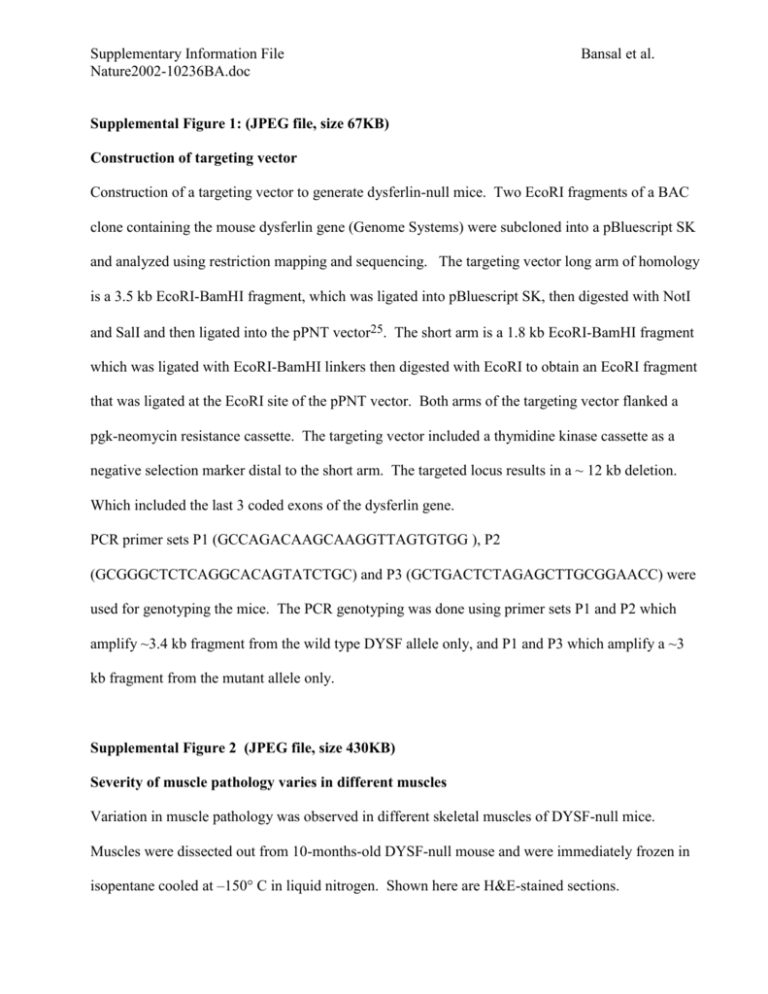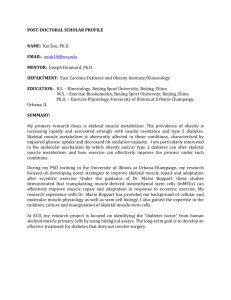Word file (28 KB )
advertisement

Supplementary Information File Nature2002-10236BA.doc Bansal et al. Supplemental Figure 1: (JPEG file, size 67KB) Construction of targeting vector Construction of a targeting vector to generate dysferlin-null mice. Two EcoRI fragments of a BAC clone containing the mouse dysferlin gene (Genome Systems) were subcloned into a pBluescript SK and analyzed using restriction mapping and sequencing. The targeting vector long arm of homology is a 3.5 kb EcoRI-BamHI fragment, which was ligated into pBluescript SK, then digested with NotI and SalI and then ligated into the pPNT vector25. The short arm is a 1.8 kb EcoRI-BamHI fragment which was ligated with EcoRI-BamHI linkers then digested with EcoRI to obtain an EcoRI fragment that was ligated at the EcoRI site of the pPNT vector. Both arms of the targeting vector flanked a pgk-neomycin resistance cassette. The targeting vector included a thymidine kinase cassette as a negative selection marker distal to the short arm. The targeted locus results in a ~ 12 kb deletion. Which included the last 3 coded exons of the dysferlin gene. PCR primer sets P1 (GCCAGACAAGCAAGGTTAGTGTGG ), P2 (GCGGGCTCTCAGGCACAGTATCTGC) and P3 (GCTGACTCTAGAGCTTGCGGAACC) were used for genotyping the mice. The PCR genotyping was done using primer sets P1 and P2 which amplify ~3.4 kb fragment from the wild type DYSF allele only, and P1 and P3 which amplify a ~3 kb fragment from the mutant allele only. Supplemental Figure 2 (JPEG file, size 430KB) Severity of muscle pathology varies in different muscles Variation in muscle pathology was observed in different skeletal muscles of DYSF-null mice. Muscles were dissected out from 10-months-old DYSF-null mouse and were immediately frozen in isopentane cooled at –150° C in liquid nitrogen. Shown here are H&E-stained sections. Supplemental Figure 3 (JPEG file, size 248KB) Stable DGC complex in DYSF-null skeletal muscle The DGC was purified from the total skeletal muscle homogenates of DYSF-null and WT mice as described previously25 using wheat germ agglutinin column (WGA) and centrifuged through 5-30% sucrose gradients. Fractions 1-14 were collected from the sucrose gradients and were electrophoresed on a 3-15 % SDS-PAGE. To identify fractions enriched in DGC components, immunoblot analysis was performed using antibodies against DGC components. While mutation in DGC components causes disruption of DGC9,11,25, a stable complex was observed in DYSF-null skeletal muscle similar to WT skeletal muscle. Supplementary movies for the membrane repair assay 1. Movie file WT+Ca2+ (Quicktime movie, 151KB) 2. Movie file WT-Ca2+ (Quicktime movie, 156KB) 3. Movie file DYF-null+Ca2+ (Quicktime movie, 153KB) 4. Movie file DYSF-null-Ca2+ (Quicktime movie, 184KB) Movies of the muscle membrane repair assay described in Figure 5 are included. WT+Ca2+ and DYSF-null+Ca2+ shows the membrane assays performed in presence of calcium on wild type and DYSF-null muscle fibers respectively. WT-Ca2+ and DYSF-null-Ca2+ shows the repair assays performed in the absence of calcium on wild type and dysferlin-null muscle fibers respectively. -2-







